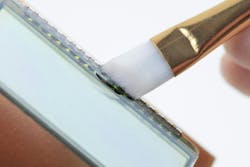Low Viscosity, Optically Clear Epoxy Passes ISO 10993-5 Standard
Developed for medical device applications, Master Bond EP21LSCL-2Med is a two component non-cytotoxic epoxy for bonding, sealing, coating and potting. While most if not all epoxies will yellow over time, especially upon exposure to heat and intense UV light, EP21LSCL-2Med has been designed to resist yellowing to a greater extent than conventional systems. This unique feature makes it ideal for imaging applications or other medical devices where optical clarity is needed.
EP21LSCL-2Med is an optically clear compound with a refractive index of 1.57. It has a high glass transition temperature of 110-120°C and a service temperature range of -60°F to +350°F (-52°C to +177°C). This system has a 100:20 mix ratio by weight, and a low mixed viscosity of 600-900 cps at room temperature. It is a moderate heat cured epoxy which features an exceptionally long gel time of 6-8 hours at room temperature for a 100-gram batch. EP21LSCL-2Med cures at room temperature followed by a post cure of 3-5 hours at 140-175°F (60-80°C).
EP21LSCL-2Med adheres well to many substrates including but not limited to metals, composites, glass, ceramics, and plastics. It offers a tensile strength of 8,000-9,000 psi and a tensile modulus of 325,000-375,000 psi. This epoxy resists many sterilization methods such as steam sterilization, liquid sterilants, anti-bacterial agents, and Ethylene Oxide.
The shelf life of EP21LSCL-2Med is 6 months in its original, unopened containers, and it is available in kits ranging from ½ pints to 5 gallon pails, as well as specialty packaging in pre-mixed and frozen syringes requiring storage at –40°C.
Master Bond Biocompatible Adhesives
Master Bond offers adhesives, sealants, coatings and potting/encapsulation compounds that pass one or both standard tests used to determine their suitability for medical device applications: U.S. Pharmacopeia (USP) Class VI for biocompatibility and/or ISO 10993-5 for non-cytotoxicity. These compounds include epoxies, silicones, UV/LED light, or dual curing systems and other chemistries. Read more about Master Bond’s biocompatible adhesive systems for medical devices at https://www.masterbond.com/properties/biocompatible-adhesives or contact technical support to discuss your application.
